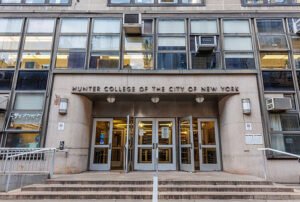
More than 650,000 people are released from prison each year. Studies show that approximately two-thirds of these individuals will likely be rearrested within three years of release.
A significant factor driving these recidivism rates is a lack of employment opportunities. After one year of release, an estimated 60 percent of formerly incarcerated people remain unemployed.
Even though many states have “Ban the Box” laws to prevent hiring discrimination, many employers are still reluctant to hire people with criminal records. Many formerly incarcerated people have to accept jobs with low wages, which often fuels the cycle of poverty that led many of them into incarceration to begin with.
Because they face so many barriers once they are released, it is increasingly important for incarcerated people to have access to employment and training opportunities that will give them a better chance of thriving after their sentence is complete.
The Last Mile, a California-based nonprofit, is one organization working to provide such resources. Founded in San Quentin Prison in 2010 by venture capitalist Chris Redlitz and his wife, Beverly Parenti, the organization provides education and technology training to incarcerated individuals.
In 2014, it became the first organization in the country to offer coding classes inside a US prison. Since its founding, The Last Mile has expanded to seven states and 20 classrooms across the country. With the program’s help, over 700 justice-impacted people have reintegrated into society and gained employment and wraparound support.
NPQ recently spoke with Kevin McCracken, The Last Mile’s newly appointed executive director, about the organization’s work to combat recidivism. As a formerly incarcerated person himself, McCracken notes that the key to combating incarceration is education and employment opportunities—not tough-on-crime laws.
Rebekah Barber: How did your background lead you to work to combat recidivism?
Kevin McCracken: I spent a good portion of my twenties bouncing in and out of county jails and rehabilitation centers for substance use disorder. That was in the 90s.
When I got out of rehab the last time, I had a felony record and was searching for work. Especially then, it was even more difficult because there was no Ban the Box [policy].
“The best way to solve the problem of recidivism is not to send them to prison in the first place but to give them education.”
If you didn’t disclose that you had a record and they did a background check, not only would you not get that job, but you likely wouldn’t be considered for anything else in that company.
I was struggling to find work, and I finally found a job at a screen printing shop that was hiring men and women who were formerly incarcerated or formerly homeless. I checked both of those boxes.
Once I started working there, I realized I would have the opportunity to help others. I realized that social enterprise work was my calling. For the last 25 years, I have been working in social enterprises with the primary goal of giving sustainable jobs to individuals who need them.
RB: Through your experience, what have you found to be the best ways to address recidivism?
KM: I think we have a systemic problem in low-income communities, especially around education. The best way to solve the problem of recidivism is not to send them to prison in the first place but to give them education.
Once people are in a situation where they’re incarcerated, it’s really important to understand that rehabilitative programming works.
The Last Mile is a great example, with an under 5 percent recidivism rate. We have really set a new precedent for creating job opportunities and a sustainable wage for individuals by giving them proper training while they’re incarcerated and following it up with support services.
Part of what we do is have an alumni success team. All of them are life-coach certified. They work with our alumni to make sure that they’re building out their resumes and getting prepared for interviews.
We are cautious about working with employers with fair chance opportunities, so we don’t deal with the disappointment of getting the conditional offer, doing a background check, and being rejected because of their history. It’s really a holistic approach.
I honestly was pretty lucky because there wasn’t any of this going on 24 years ago when I was looking for work. There were some employers who would hire, but it wasn’t exactly what I was looking for in terms of a long-term career.
From my experience, support is a major part of this. What we try to do is support our alumni in their choices around what careers they want to pursue.
RB: What makes The Last Mile unique compared to other programs that seek to address recidivism?
KM: The biggest thing is that we were the first organization to offer coding inside a prison facility. We now offer audio and video production, and we have strong relationships with many organizations in the Los Angeles area.
Sign up for our free newsletters
Subscribe to NPQ's newsletters to have our top stories delivered directly to your inbox.
By signing up, you agree to our privacy policy and terms of use, and to receive messages from NPQ and our partners.
We have amazing content partners, including [tech training companies] Frontend Masters and O’Reilly Media. On the audio/video side, we work with Avid, the maker of Pro Tools—the industry standard in audio and engineering. We also work with DaVinci [Resolve], a fantastic filmmaking platform.
All of these individuals or organizations offer us free content. They give us licenses. They give us content. They give us learning materials. We have an excellent group of curriculum writers that build the curriculum—not only custom but based on free content that we get from these providers.
Then, we have a really powerful delivery system. We use Canvas, which is the standard for high schools and colleges. Our students are doing the same thing they would be doing in a college if they had any type of remote instruction or had to upload papers on a system.
It’s a combination of being innovative in what we’re doing and taking a unique approach in using remote instruction. Many of our instructors have been through our program and are now working for The Last Mile. So, there’s a relatedness and camaraderie there that you don’t get from other programs.
“We’re not interested in red or blue….What we’re most interested in is what you’re willing to do if you truly care about all of your constituents.”
We also offer our reentry professional development (RPD) program, which helps our learners understand what it’s going to look like when they go to the parole board and prepares them for interviews and helps them create resumes around durable skills, in addition to the hard skills that they’re learning.
We’ve been around for almost 15 years, and we’ve been doing the technology part for 10 years. We’re a decade ahead of most other organizations. There are new organizations doing this now, but we…do things in a way that is truly unique to The Last Mile.
RB: As you’ve expanded to different states, what have you found some of the challenges to be?
KM: The single biggest challenge is getting the infrastructure into the facility. For our program, we require two fiber lines dedicated to The Last Mile. It’s a heavier lift to get the fiber in than to get everything else installed. Because many prisons are old and don’t have that infrastructure, getting that installation can be a huge barrier for us.
Also, there’s a lack of understanding around how important rehabilitative programming is—but a lot of states are catching up. One of the things we’ve noticed, especially over the last five years is it’s becoming less and less a political issue and more and more a human rights issue. We’re on the forefront of that narrative.
We do great work [with] Eric Holcomb of Indiana, who is as conservative a governor as you’re going to find in the United States. We also do great work with Gavin Newsome of California, who is the most liberal governor in the United States.
We’re not interested in red or blue, and we’re not interested in what political party we’re a part of. What we’re most interested in is what you’re willing to do if you truly care about all of your constituents.
“If we’re spending these really valuable resources on anything, it should be our students.”
RB: Can you talk about anything else you would like to see from political leaders?
KM: The obvious answer is to look at the facts themselves. Stop pretending that you’re going to be [tough on] crime and punishment and [that] that’s going to solve the problem.
It does not. It has not. It will not. There’s no factual evidence that shows that harsher sentences, including the death penalty, are a deterrent to crime. It’s just not the case.
I would love government officials, especially state officials, to be more honest. The solution is better infrastructure and funding for our public schools—especially in marginalized communities, poor communities, and communities of color.
The fact of the matter is that the better people’s education is, and the higher education they receive, the less likely they are to commit a crime. If we’re spending these really valuable resources on anything, it should be our students. It should be taking care of our youth and making sure that if they’re in a situation where they’ve got an incarcerated parent, that they’re getting their needs met and there’s trauma-informed care inside the school.
It’s traumatic for kids to lose a parent to incarceration. After the 1994 Crime Bill, we lost almost an entire generation of Black and Brown men to incarceration.
Political leaders need to understand brain science. We’re still sentencing youth to long sentences and life sentences. In any other country in the world, a life sentence is banned for anyone under 18 because it is essentially torture. Political leaders need to look at the reality of what people can and cannot do in terms of decision-making. Your brain isn’t fully developed until you’re over 25.
I would ask political leaders to consider three things when creating harsh sentencing laws: better education, a better understanding of brain science, and rehabilitation programming.
The United States is one of the most innovative countries in the world. Why can’t we solve this problem? We have 25 percent of the prison population in the entire world, and we certainly don’t have 25 percent of the world’s population.












